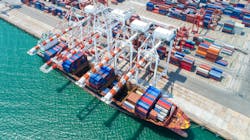Of supply chain, aging trucks, parts availability, and private equity
There is so much going on in the world that is affecting trucking, and I thought it might be helpful to have it all down in one place to gain a better understanding of the entire picture.
Most of the news is focused on supply chain disruption and material shortages—most critically microchips—that is plaguing the trucking industry as well as impacting the overall economy.
Interestingly, even manufacturers do not have good answers about when the situation will be resolved and when they will be able to deliver orders.
We do know that COVID-19 continues to play a role in these delays as suppliers in other countries continue to contend with shutdowns in response to additional outbreaks. Currently, this is delaying the supply chain by four to six weeks, which in turn delays production schedules at vehicle manufacturing plants.
The current supply chain crisis has caused some people to wonder why we are not sourcing more products and components domestically. The answer is we do not currently have enough suppliers in the U.S. to meet demand. Even if we try to shorten the supply chain at this point, manufacturing is a business that cannot turn on a dime. R&D and tooling are involved in starting new plants, and it takes time to develop long-term sourcing contracts and supplier relationships.
While much of the focus on the current supply chain crisis is on whole goods, the reality is that capital equipment is not the only area being impacted. We also are seeing issues with tires, oils/lubes, steel, aluminum—you name it—and there is likely a supply chain issue.
The problem is exacerbated by regulations at the ports in California and restrictions on what trucks may enter the ports. Also, there are staffing issues at the ports from drivers to warehouse workers to longshoremen. Ports are open 24/7 and yet only 60% of the available pickup slots are being utilized. Wait times at ports are excessively long, making it an even less attractive option for the limited equipment and smaller number of drivers. Why wait at the port and carry one load a day when you could work in other areas and carry multiple loads during your allowed hours of service?
The supply chain issues that have pushed truck order deliveries out into 2023 mean that fleets are having to rely on older equipment to ensure they can deliver goods. This increased burden on older equipment results in more maintenance and repair of those vehicles. However, those repairs also are being delayed because parts are not available. As I mentioned, the supply chain issues are impacting everything, and repair parts are not excluded.
Everything that is happening is compounding an already bad situation. Unfortunately, there is no magical solution that will make this problem go away any time soon.
While all this is going on, the age-old supply-and-demand rationale has made trucking companies attractive targets for investors. Private equity firms are looking to buy these companies and consolidate operations and, in many cases, this is making it more difficult for smaller fleets to compete.
My hope is that we will be able to come up with some real, concrete solutions by seeing the complexity and depth of the issues the trucking industry is facing. Regulations that impede efficiency and limit the flow of goods into the market need to be reevaluated to see if there is a better way. The flow of containers in and out of ports should be much quicker.
As a global team effort, we need to analyze every aspect of the supply chain and determine where we have pinch points and how we can quickly eliminate them.
Patrick Gaskins, SVP of Corcentric Fleet Solutions, oversees both sales and operations for the company's fleet offerings. Gaskins joined the company in 2010, bringing more than 30 years of experience as a financial services professional in the transportation industry. He leads a team that works with a supply base of more than 160 manufacturers to help the country’s largest fleets manage all aspects of their fleet operations and fleet-related spend.
About the Author

Patrick Gaskins
Senior vice president, Fleet Solutions
Pat Gaskins is the senior vice president of Corcentric Fleet Solutions, where he leads both the sales and operations teams for the company’s fleet offerings. He has over 30 years of experience as a financial services professional in the transportation industry and manages partnerships with over 160 manufacturers, helping over 2,000 of the country’s largest fleets manage all aspects of their fleet operations and fleet-related spend.
